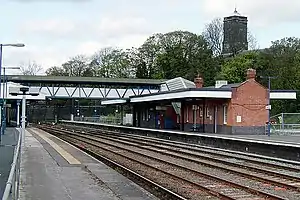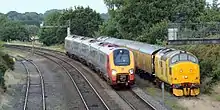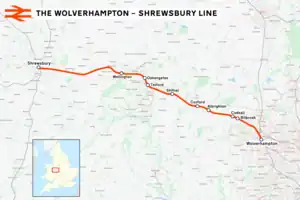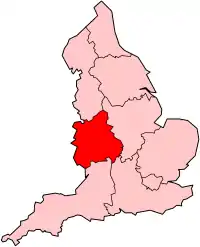Wolverhampton–Shrewsbury line
The Wolverhampton–Shrewsbury line is the railway line from Wolverhampton to Shrewsbury via Wellington; it was originally built by the Shrewsbury and Birmingham Railway. The line is double track throughout, with rarely used relief sidings at Cosford and four tracks through Wellington station.
| Wolverhampton–Shrewsbury line | |||
|---|---|---|---|
 Wellington station | |||
| Overview | |||
| Owner | Network Rail | ||
| Locale | |||
| Termini | |||
| Service | |||
| Rolling stock | |||
| Technical | |||
| Track gauge | 1,435 mm (4 ft 8+1⁄2 in) standard gauge | ||
| |||
Wolverhampton to Shrewsbury Line | |||||||||||||||||||||||||||||||||||||||||||||||||||||||||||||||||||||||||||||||||||||||||||||||||||||||||||||||||||||||||||||||||||||||||||||||||||||||||||||||||||||||||||||||||||||||||||||||||||||||||||||||||||||||||||||||||||||||||||||||||||||||||||||||
|---|---|---|---|---|---|---|---|---|---|---|---|---|---|---|---|---|---|---|---|---|---|---|---|---|---|---|---|---|---|---|---|---|---|---|---|---|---|---|---|---|---|---|---|---|---|---|---|---|---|---|---|---|---|---|---|---|---|---|---|---|---|---|---|---|---|---|---|---|---|---|---|---|---|---|---|---|---|---|---|---|---|---|---|---|---|---|---|---|---|---|---|---|---|---|---|---|---|---|---|---|---|---|---|---|---|---|---|---|---|---|---|---|---|---|---|---|---|---|---|---|---|---|---|---|---|---|---|---|---|---|---|---|---|---|---|---|---|---|---|---|---|---|---|---|---|---|---|---|---|---|---|---|---|---|---|---|---|---|---|---|---|---|---|---|---|---|---|---|---|---|---|---|---|---|---|---|---|---|---|---|---|---|---|---|---|---|---|---|---|---|---|---|---|---|---|---|---|---|---|---|---|---|---|---|---|---|---|---|---|---|---|---|---|---|---|---|---|---|---|---|---|---|---|---|---|---|---|---|---|---|---|---|---|---|---|---|---|---|---|---|---|---|---|---|---|---|---|---|---|---|---|---|---|---|---|
| |||||||||||||||||||||||||||||||||||||||||||||||||||||||||||||||||||||||||||||||||||||||||||||||||||||||||||||||||||||||||||||||||||||||||||||||||||||||||||||||||||||||||||||||||||||||||||||||||||||||||||||||||||||||||||||||||||||||||||||||||||||||||||||||
Electrification from Stafford Road Junction to Oxley, is provided solely to enable electric stock to access Alstom's Oxley TRSMD, and is therefore constructed as a "trolley wire" suitable for low speeds only.[1]
Signalling was centred in the panel box at Madeley Junction until 2012,[2] but following the closure of the box there, the West Midlands Signalling Centre at Saltley has taken control of most of the route via its Oxley/Telford Workstation. Previously, Oxley signal box controlled the depot access and sidings until it closed on 27 November 2010 under the West Midlands Resignalling scheme. Towards Shrewsbury, Abbey Foregate signal box takes over for the last few miles beyond Wellington.
The line also had a service to Walsall which ran to Wellington via Wolverhampton, but this service was cutback to Wolverhampton, and then eventually withdrawn altogether.
History
The line was opened by the Shrewsbury and Birmingham Railway (S&BR) in 1849, which merged with the Great Western Railway (GWR) in 1854. In GWR days, until the 1960s it formed part of an important main line route from London Paddington to Birkenhead Woodside. The line historically ran into the GWRs Wolverhampton Low Level railway station, before the latter was closed to passenger services in 1972, it now runs into the nearby former High Level Wolverhampton railway station.[3]
Telford Central railway station was opened on the line by British Rail in 1986, to serve the new town of Telford, which had grown up along its route since the late-1960s.
Route
The towns and villages served by the route are listed below, East to West.
- Wolverhampton (City of Wolverhampton) – 6 platforms
- Bilbrook (Staffordshire) – 2 platforms
- Codsall (Staffordshire) – 2 platforms
- Albrighton (Shropshire) – 2 platforms
- Cosford (Shropshire) – 2 platforms
- Shifnal (Shropshire) – 2 platforms
- Telford Central (Telford and Wrekin) – 2 platforms
- Oakengates (Telford and Wrekin) – 2 platforms
- Wellington (Telford and Wrekin) – 3 platforms
- Shrewsbury (Shropshire) – 5 platforms (numbered 3 to 7)
The map includes the former GWR Madeley Branch[4] which formed a connection from Madeley Junction to the Wellington to Craven Arms Railway at Lightmoor Junction.
Passenger services

Avanti West Coast, Transport for Wales and West Midlands Trains operate passenger trains on this line. Westbound, some trains go beyond Shrewsbury to Chester, Holyhead, Pwllheli, Aberystwyth and Wrexham General while eastbound, all services continue beyond Wolverhampton to Birmingham New Street and/or Birmingham International, with some trains continuing to London Euston.[5]
West Midlands Trains operate one service per hour in each direction on the line; this service calls at all local stations to Wolverhampton before continuing to Birmingham New Street. There is an additional service in each direction in the peak times again, calling at all local stations. These services are operated using British Rail Class 196 Diesel Multiple Units, which were introduced into service in late 2022 and early 2023 following the withdrawal of British Rail Class 170 Diesel Multiple Units
Transport for Wales operate one service per hour in each direction on the line; this service calls at Telford Central and Wellington only before continuing to Birmingham International westbound or to Chester, Holyhead, Pwllheli, Aberystwyth or Wrexham General when heading eastbound. These services are typically operated using the British Rail Class 158 but sometimes use British Rail Class 150 or British Rail Class 153 both of which are Diesel Multiple Units
Since December 2014, Virgin Trains (now Avanti West Coast) have run a daily return services between Shrewsbury and London Euston calling at Wellington and Telford Central only. These services are operated using British Rail Class 221 Diesel Multiple Unit. However, they will be replaced with British Rail Class 805 Bi-Mode Multiple Unit in the near future
Freight

The Coalbrookdale line, which served Ironbridge Power Station to the south of Telford near Ironbridge, joined the Wolverhampton–Shrewsbury line at Madeley Junction, which is between Telford Central and Shifnal stations.[6] Coal trains ran by EWS up to 2012 and by Fastline up to 2010[7] used the route, supplying the power station. Between 2012 and 2015, the power station was converted to run on biomass which was supplied mostly via Liverpool Docks by GBRf trains until closure of the plant in November 2015.[8]
In 2008 the former Wellington to Stafford line was rebuilt as far as Donnington, for freight use. Telford International Railfreight Park is located at a 48 acres (0.19 km2) site just off the Hortonwood Roundabout near Donnington which opened in 2009. The reopened line is single track and runs for 2 miles 68 chains (4.6 km) from the junction with the Wolverhampton–Shrewsbury line at Wellington (0.25 miles (0.40 km) east of Wellington station). Currently the only rail business to and from the site is Ministry of Defence traffic[9] which runs down from Warrington so only uses a brief portion of the line between Shrewsbury and Wellington.[10]
References
- Slater, J N, ed. (January 1972). "Trolley wire for sidings". The Railway Magazine. Vol. 118, no. 849. London: Transport Press. p. 42. ISSN 0033-8923.
- "Madeley Junction" The Signal Box discussion forum; Retrieved 3 August 2017
- Christiansen, Rex (1983). A Regional History of the Railways of Great Britain, Volume 7 The West Midlands. David St John Thomas David & Charles. ISBN 0-946537-00-3.
- Ordnance Survey Map Shropshire XLIII.11, Revised: 1901, Published: 1902
- GB eNRT May 2019 Edition, Table 74 & 75
- Bridge, Mike (2013). Railway Track Diagrams – Midland and North West. Bradford-on-Avon: Trackmaps. p. 21. ISBN 978-0-9549866-7-4.
- Buck, Martin (2010). Loco Review 2011. Swindon: Freightmaster Publishing. p. 26. ISBN 978-0-9558275-4-9.
- Shannon, Paul (20 January 2016). "Feeding the nations power stations". Rail Magazine. No. 792. p. 49.
- Shannon, Paul (December 2013). "On government business". Railways Illustrated. 11 (12): 84. ISSN 1479-2230.
- Rawlinson, Mark (November 2015). "Freighmaster 80". Freightmaster (80): 75. OCLC 904391334.

